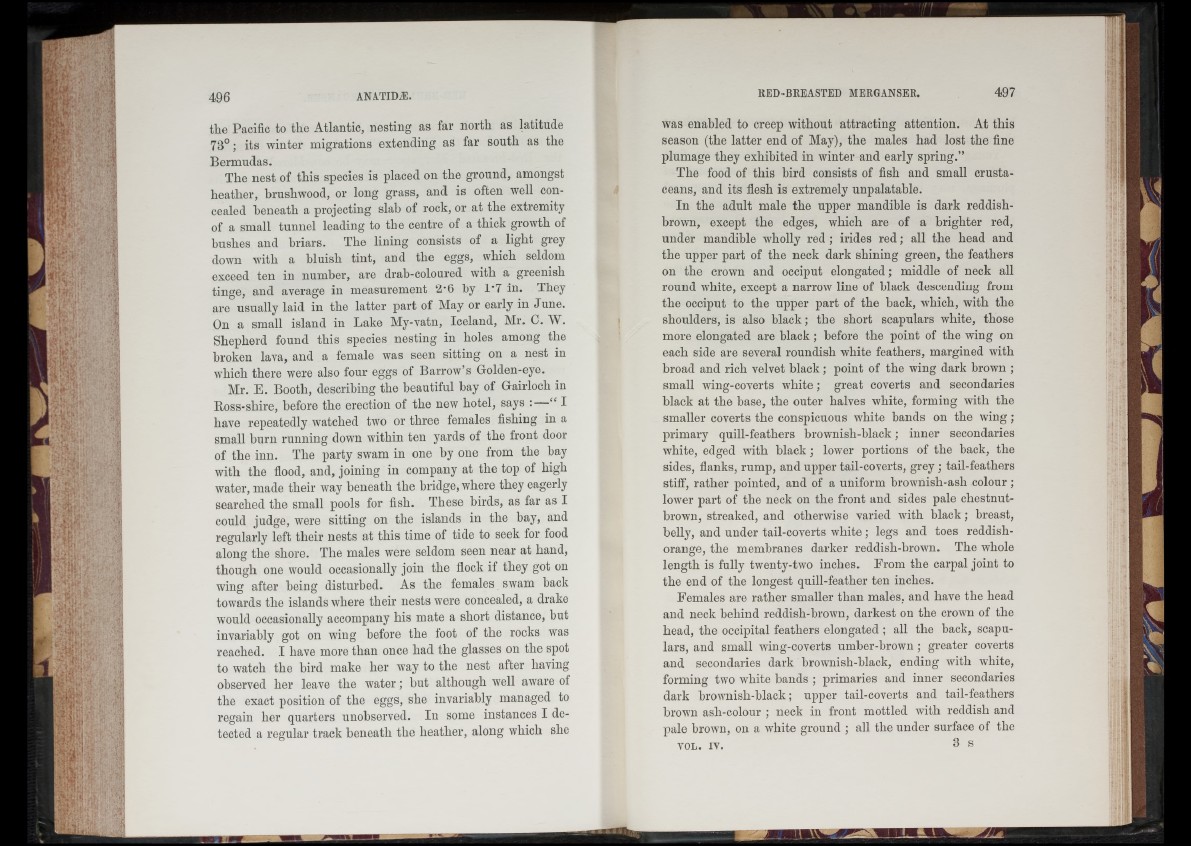
the Pacific to the Atlantic, nesting as far north as latitude
73°; its winter migrations extending as far south as the
Bermudas.
The nest of this species is placed on the ground, amongst
heather, brushwood, or long grass, and is often well concealed
beneath a projecting slab of rock, or at the extremity
of a small tunnel leading to the centre of a thick growth of
bushes and briars. The lining consists of a light grey
down with a bluish tint, and the eggs, which seldom
exceed ten in number, are drab-coloured with a greenish
tinge, and average in measurement 2‘6 by 1*7 in. They
are usually laid in the latter part of May or early in June.
On a small island in Lake My-vatn, Iceland, Mr. C. W.
Shepherd found this species nesting in holes among the
broken lava, and a female was seen sitting on a nest in
which there were also four eggs of Barrow’s Golden-eye.
Mr. E. Booth, describing the beautiful bay of Gairloch in
Ross-shire, before the erection of the new hotel, says : “ I
have repeatedly watched two or three females fishing in a
small burn running down within ten yards of the front door
of the inn. The party swam in one by one from the bay
with the flood, and, joining in company at the top of high
water, made their way beneath the bridge, where they eagerly
searched the small pools for fish. These birds, as far as I
could judge, were sitting on the islands in the bay, and
regularly left their nests at this time of tide to seek for food
along the shore. The males were seldom seen near at hand,
though one would occasionally join the flock if they got on
wing after being disturbed. As the females swam back
towards the islands where their nests were concealed, a drake
would occasionally accompany his mate a short distance, but
invariably got on wing before the toot of the rocks was
reached. I have more than once had the glasses on the spot
to watch the bird make her way to the nest after having
observed her leave the water; but although well aware of
the exact position of the eggs, she invariably managed to
regain her quarters unobserved. In some instances I detected
a regular track beneath the heather, along which she
was enabled to creep without attracting attention. At this
season (the latter end of May), the males had lost the fine
plumage they exhibited in winter and early spring.”
The food of this bird consists of fish and small crustaceans,
and its flesh is extremely unpalatable.
In the adult male the upper mandible is dark reddish-
brown, except the edges, which are of a brighter red,
under mandible wholly red; irides red; all the head and
the upper part of the neck dark shining green, the feathers
on the crown and occiput elongated; middle of neck all
round white, except a narrow line of black descending from
the occiput to the upper part of the back, which, with the
shoulders, is also black; the short scapulars white, those
more elongated are black; before the point of the wing on
each side are several roundish white feathers, margined with
broad and rich velvet black ; point of the wing dark brown ;
small wing-coverts white; great coverts and secondaries
black at the base, the outer halves white, forming with the
smaller coverts the conspicuous white bands on the wing ;
primary quill-feathers brownish-black; inner secondaries
white, edged with black ; lower portions of the back, the
sides, flanks, rump, and upper tail-coverts, grey ; tail-feathers
stiff, rather pointed, and of a uniform brownish-ash colour ;
lower part of the neck on the front and sides pale chestnut-
brown, streaked, and otherwise varied with black; breast,
belly, and under tail-coverts white ; legs and toes reddish-
orange, the membranes darker reddish-brown. The whole
length is fully twenty-two inches. From the carpal joint to
the end of the longest quill-feather ten inches.
Females are rather smaller than males, and have the head
and neck behind reddish-brown, darkest on the crown of the
head, the occipital feathers elongated ; all the back, scapulars,
and small wing-coverts umber-brown ; greater coverts
and secondaries dark brownish-black, ending with white,
forming two white bands ; primaries and inner secondaries
dark brownish-black; upper tail-coverts and tail-feathers
brown asli-colour ; neck in front mottled with reddish and
pale brown, on a white ground ; all the under surface of the
VOL. iv. 3 s